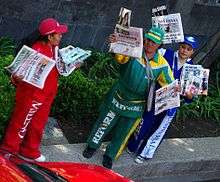Newspaper hawker
- A newsboy may also be a paperboy (newspaper delivery) carrier.
A newspaper hawker, newsboy, newsie is a street vendor of newspapers without a fixed newsstand.

History
| “ | To the unemployed—A number of steady men can find employment by vending this paper. A liberal discount is allowed to those who buy and sell again. | ” |
| — Benjamin Day[1] | ||
Benjamin Franklin is sometimes called the "first American newsboy", as he helped deliver his brother's New England Courant in 1721. But the real beginning of the trade of newsboy comes in 1833, when the New York Sun started hiring vendors in New York City in 1833. At the time, newspapers were generally either picked up at the newspaper's office, sent by mail, or delivered by printers' apprentices or other employees.[1] The Sun, by contrast, was not sold in stores or by subscription.[2] Its publisher, Benjamin Day, recruited unemployed people using help-wanted notices to vend his newspaper. Instead of the adults he expected, his ad drew children: the first was the 10-year-old Irish immigrant Bernard Flaherty, who turned out to be a talented hawker—later a stage comedian—who would cry out the day's most sensational headlines: "Double Distilled Villainy"; "Cursed Effects of Drunkenness!"; "Awful Occurrence!"; "Infamous Affair!".[3] These newsboys could either hawk to passersby on the street or establish subscription routes; many did both.[1]
Newspaper boys, also called 'newsboys' or 'newsies', were the main distributors of newspapers to the general public from the mid-19th to the early 20th century in the United States. They were not employees of the newspapers but rather purchased the papers from the publishers and sold them as independent agents. Not allowed to return unsold papers, the newsboys typically earned around 30 cents a day and often worked until very late at night.[4] Cries of "Extra, extra!" were often heard into the morning hours as newsboys attempted to hawk every last paper.[5]
Newsboys were not often well received. In 1875 a popular writer of the period wrote, "There are 10,000 children living on the streets of New York....The newsboys constitute an important division of this army of homeless children. You see them everywhere.... They rend the air and deafen you with their shrill cries. They surround you on the sidewalk and almost force you to buy their papers. They are ragged and dirty. Some have no coats, no shoes, and no hat." However, the common ill-treatment of the newsboys was not a major concern of society.[6]
Labor actions

Newsboys struck for better pay and working conditions multiple times: 1884,[7] 1886,[8] 1887,[9] and 1889.[10]
In the newsboys' strike of July 1899, many New York newsboys refused to deliver major newspapers,[11] and asked the public to boycott them.[12] After a two-week strike, papers did not lower their prices, but did agree to buy back all unsold papers, and the union disbanded.[13]
Recent developments
In Wales, it was announced in July 2011 that Media Wales, publisher of the Western Mail and South Wales Echo, would no longer employ newspaper vendors in Cardiff city center. A spokesman said distribution of the newspaper by the vendors cost more than the newspaper received in return.[14]
See also
- Newsboy cap, a kind of hat worn by newsboys
- Newsboy Legion, a comic-book kid gang
Notes
- 1 2 3 Priscilla Ferguson Clement, Jacqueline S. Reiner, eds., Boyhood in America: An Encyclopedia, 2001, ISBN 1-57607-540-0, s.v. 'Newsboys', p. 471
- ↑ Burgan, p. 4
- ↑ Matthew Goodman, The Sun and the Moon: The Remarkable True Account of Hoaxers, Showmen, Dueling Journalists, and Lunar Man-Bats in Nineteenth-Century New York, 2010, ISBN 0786726962 p. 31
- ↑ (nd) Child labor in America 1908-1912: Photographs of Lewis W. Hine. Retrieved 17 June 2007. - See "Newsies".
- ↑ Nasau, D. (1999) p. 9.
- ↑ (nd) Newsies. Digital History. Retrieved 10 February 2014.
- ↑ "Newsboys strike", New York Times. October 14, 1884. Retrieved 14 February 2008.
- ↑ "Newsboys indulge in a strike", New York Times. March 30, 1886. Retrieved 14 February 2008.
- ↑ "Strike of newsboys", New York Times. January 29, 1887. Retrieved 14 February 2008.
- ↑ "Newsboys on strike: Many fights and two arrested by police", New York Times. August 13, 1889. Retrieved 14 February 2008.
- ↑ "Newsboys Go On Strike". 21 July 1899: 1.
- ↑ "Plans to Down Newsboys". The Sun. 24 July 1899.
- ↑ Mott, F.L. (2000) American Journalism. New York: Routledge. p. 598.
- ↑ "Paul Linford, "Welsh Dailies Abandon City Centre Street Sales,"". Holdthefrontpage.co.uk. Retrieved 2014-04-26.
References
- Michael Burgan, The American Newsboy, 2006, ISBN 075652458X